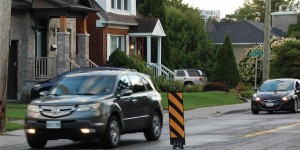John Dance
Centre line signage, gateway speed limit zones aimed at slowing traffic speed and reducing drivers’ inattentiveness while travelling our community’s streets
Slow down!” A variety of measures taken by the City of Ottawa are clearly sending this message to motorists in Old Ottawa East. And the general reaction is, “OK, but now do it on my street, too!” The first of these measures was the installation of “flexible centre line signage,” as the City describes it, on Marlowe Crescent and on Clegg, Toronto and Hazel streets to slow down traffic and make drivers pay more attention.
“The signs are 1.2 metres high by 32.4 centimetres wide,” according to a CTV report. “They are flexible and are mounted on a spring base so they can be run over by wider vehicles, or inattentive drivers.” The signs, like the flex-posts on the Smyth Road bridge bike lanes, will be removed for winter snow clearing and then reinstalled in the spring.
And there seem to be a number of inattentive drivers, given that a few of the new signs show the marks of being run over numerous times. The signs are funded as part of Councillor Shawn Menard’s $50,000 budget for traffic calming in Capital Ward.
A second program funded through Menard’s budget is the creation of “gateway speed limit signs,” that, according to the City website, identify the beginning and end of a legal speed limit that applies to all roadways within an area.
In September, City Council approved a gateway speed limit zone of 30 km/h for the streets west of Main Street between Riverdale Avenue and Hawthorne Avenue. The speed reduction will not apply to the major routes of Old Ottawa East (i.e., Main, Hawthorne, Lees Avenue, and Greenfield Avenue), however, Tom Scott, OOECA transportation director, has received the commitment of Menard that the Greenfield speed limit will be reduced to 40 next year. Also, in 2021, Menard will seek approval of a gateway speed limit zone for streets east of Main.
Old Ottawa South (OOS) received Capital Ward’s first gateway speed limit zone last year and Sue Neill, Ottawa South Community Association’s chair of traffic and safety committee, says, “There hasn’t been a night and day change in speed of vehicles in OOS since the new 30 km/h limit was implemented and I suspect that it will take some time. One of the benefits of the gateway speed zone is that all new road construction will include safety measures to reduce speed. This is good!”
Other traffic safety improvements for the community and its neighbours this summer include approval of wide pedestrian-cycling lanes over the Bank Street Canal bridge achieved through the removal of one motorized vehicle lane; a signalized pedestrian crossing of Colonel By Drive at Seneca Street in Old Ottawa South, accompanied by a reduction in the Colonel By speed limit to 40 km/h in the stretch between Bank and Bronson as well,” says John Bennett. “There are a lot of young children on this street and it is great to see them out having fun on scooters and small bikes, playing basketball, and walking dogs. This is part of what makes a great neighbourhood and heathy, happy children. Most drivers are careful and drive slowly but there are some who drive too fast, and there has been the occasional alarming case of someone — impatient or angry or both — driving down the street at high speed. The middle-of-the-road signs would make the street safer for all.”
Drummond Street reidesnt Linda Kristal “really likes” the new sign in the middle of Hazel, almost at the corner of Drummond. “Sometimes cars park too close to it to get around, but overall it has made the drive through traffic slow down and made it much safer for the kids who play in the street,” she says. “I wish the car parkers would exercise more judgement, but that is a small irritant compared to the much safer speed it forces on drivers.”
But there is a different reaction from some residents on Toronto Street. For many years, the primary problem there has been speeding drivers on the adjacent Main Street. Janice Isaac-Rowan says, “…we’ve watched people drive right over the yellow/black signs positioned in the middle of the road. They drive so fast off the[Smyth] bridge and turn so fast onto Toronto Street that there’s no way they are reading the overly large “Traffic Calming” sign that is posted eight feet from the corner. Maybe parked cars would have slowed traffic better.”
Reduced speed limits on Main Street and real police enforcement are concerns of many residents living on the busy street, and residents of Lees, Greenfield and Hawthorne avenues have similar thoughts about their heavily-used streets. “It would be nice to see a speed bump on the Lees Avenue straightaway between the 417 off ramp and Main,” says Daniel Wilson.
One other traffic concern, pursued by McGillivray Street’s Susan Peddle, is the bizarrely configured and unsafe McGillivray-McNaughton Avenue intersection. But as Tom Scott reported at the September community association meeting, the City’s response to the problem is “The intersection of McGillivray at McNaughton has zero reported pedestrian collisions in the latest 5-year collision data (2014-2018). A physical modification of the intersectionis therefore not justified at this time.”







